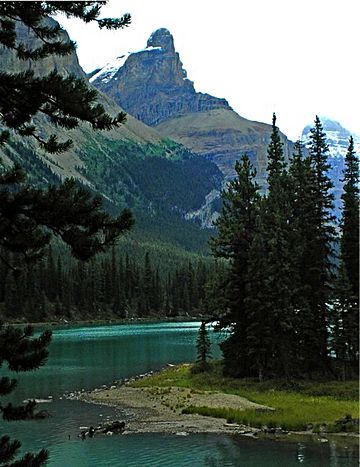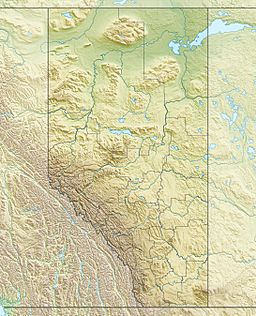Mount Paul facts for kids
Quick facts for kids Mount Paul |
|
|---|---|

Mount Paul seen from Samson Narrows on Maligne Lake
|
|
| Highest point | |
| Elevation | 2,850 m (9,350 ft) |
| Prominence | 175 m (574 ft) |
| Parent peak | Maligne Mountain (3200 m) |
| Listing | Mountains of Alberta |
| Geography | |
| Location | Alberta, Canada |
| Parent range | Queen Elizabeth Ranges Canadian Rockies |
| Topo map | NTS 83C/11 |
| Geology | |
| Age of rock | Cambrian / Ordovician |
| Type of rock | Limestone |
| Climbing | |
| First ascent | 1928 by W.R. Hainsworth and M.M. Strumia |
Mount Paul is a tall mountain in Jasper National Park, Alberta, Canada. It stands about 2,850 meters (9,350 feet) high. This impressive peak rises 1,134 meters (3,720 feet) above the eastern side of Maligne Lake. Mount Paul is part of the Canadian Rockies.
It is located north of another mountain called Monkhead. You might have seen Mount Paul in famous pictures of Spirit Island and Maligne Lake. The closest taller mountain is Maligne Mountain, which is about 1.8 kilometers (1.1 miles) away to the north-northwest.
History of Mount Paul
How Mount Paul Got Its Name
Mount Paul was named by a famous explorer named Mary Schäffer. She named it after her nine-year-old nephew, Paul Sharples. Paul went with Mary on her second trip to Maligne Lake in 1911.
Before it was called Mount Paul, Mary Schäffer had another name for it. During her first successful trip to Maligne Lake in 1908, she called the mountain The Thumb.
First Climbers and Official Name
The very first time someone successfully climbed to the top of Mount Paul was in 1928. Two climbers, W.R. Hainsworth and M.M. Strumia, made this "first ascent."
The mountain's name, Mount Paul, became official much later. The Geographical Names Board of Canada officially adopted the name in 1946.
Climate Around Mount Paul
Weather in Jasper National Park
Mount Paul is in an area with a subarctic climate. This means it has very cold winters with lots of snow. The summers are usually mild, not too hot.
Temperatures can drop really low, sometimes below −20 °C (−4 °F). With the wind, it can feel even colder, sometimes below −30 °C (−22 °F).
Water Flow from the Mountain
The snow and rain that fall on Mount Paul drain into Maligne Lake. This water then flows into the Maligne River. The Maligne River is a smaller river that eventually joins the larger Athabasca River.



